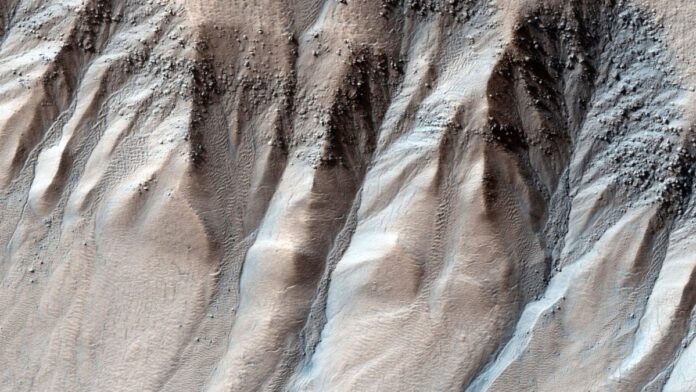Gullies on Mars may have formed when the Red Planet was highly tilted on its side, triggering dramatic shifts in climate that sent water cascading down slopes to carve out ravines, a new study finds.
Scientists first discovered gullies on Mars in 2000. These strongly resembled channels that form on Earth in the Dry Valleys of Antarctica, which are carved by water from melting glaciers. As such, the Martian ravines hinted that water once flowed on Mars, and maybe still does at times.
“They look very Earth-like, but they’re on Mars, so how could they form there?” study lead author James Dickson, a planetary scientist at the California Institute of Technology in Pasadena, told Space.com. “It’s been a great puzzle that many scientists have worked on.”
Related: Mars: Everything you need to know about the Red Planet
The problem with the possibility of gullies on Mars is that these ravines mostly exist at heights where liquid water is not expected under the current Martian climate. The air on the Red Planet is nowadays generally too cold and thin for liquid water to last very long, and is even colder and thinner at high elevations than it is at lower ones, just as is true on Earth.
Previous research has suggested these gullies might have a different source — carbon dioxide frost that sublimated, or transformed directly into vapor, when Mars experienced warm spells, causing rock and rubble to slide down slopes. However, much remains unknown about this scenario, as it does not happen in nature on Earth.
Another possibility is that these gullies formed in the past, when the climate of Mars was more favorable to small amounts of liquid water surviving on the the Martian surface. This might explain the height of the gullies — meltwater from glaciers could have flowed down slopes, chiseling out channels.
To see if liquid water could have existed on Mars, scientists examined how its axial tilt, or obliquity, has changed over time and the potential effects of this slanting. The more the poles of a planet are tilted with respect to its orbit around the sun, the more variation in how much sunlight different parts of that world receive over the course of its year.
Earth’s axial tilt of about 23.5 degrees results in its seasons. Currently, Mars’ obliquity is about 25 degrees, but it has varied between 15 and 35 degrees over the course of hundreds of thousands of years, which can produce even more dramatic changes in climate.
The researchers investigated how times of higher obliquity on Mars would lead to more extreme swings between winter and summer and potentially more favorable climates for liquid water. They developed a 3D global model of the Martian climate to see what might happen at 35 degrees obliquity.
The scientists found that at Martian locations where gullies are now found, sublimating carbon dioxide ice would have made the Martian atmosphere significantly denser. In addition, surface temperatures likely surpassed the melting point of water ice. These conditions likely occurred repeatedly over the past several million years, most recently about 630,000 years ago.
In addition, these gully areas currently have lots of water ice near the surface, and likely had far more within the last million years. The researchers suggest that during times of high axial tilt, much of this ice might have melted to carve out gullies in the high-altitude areas where they are now seen.
All in all, the scientists argue that a combination of melting ice, sublimating carbon dioxide and high obliquity can help explain the pattern of gullies seen on Mars.
“An important implication is that we can now predict that when Mars’ orbit tilts again, it should be able to generate meltwater at these gully locations,” Dickson said.
Since life on Earth is found virtually wherever there is water, future research may want to focus on these gullies on Mars to see if life once might have existed on the Red Planet, and might live there still.
“If you were to look for extant life, these locations would be good targets,” Dickson said.
The scientists detailed their findings June 30 in the journal Science.

